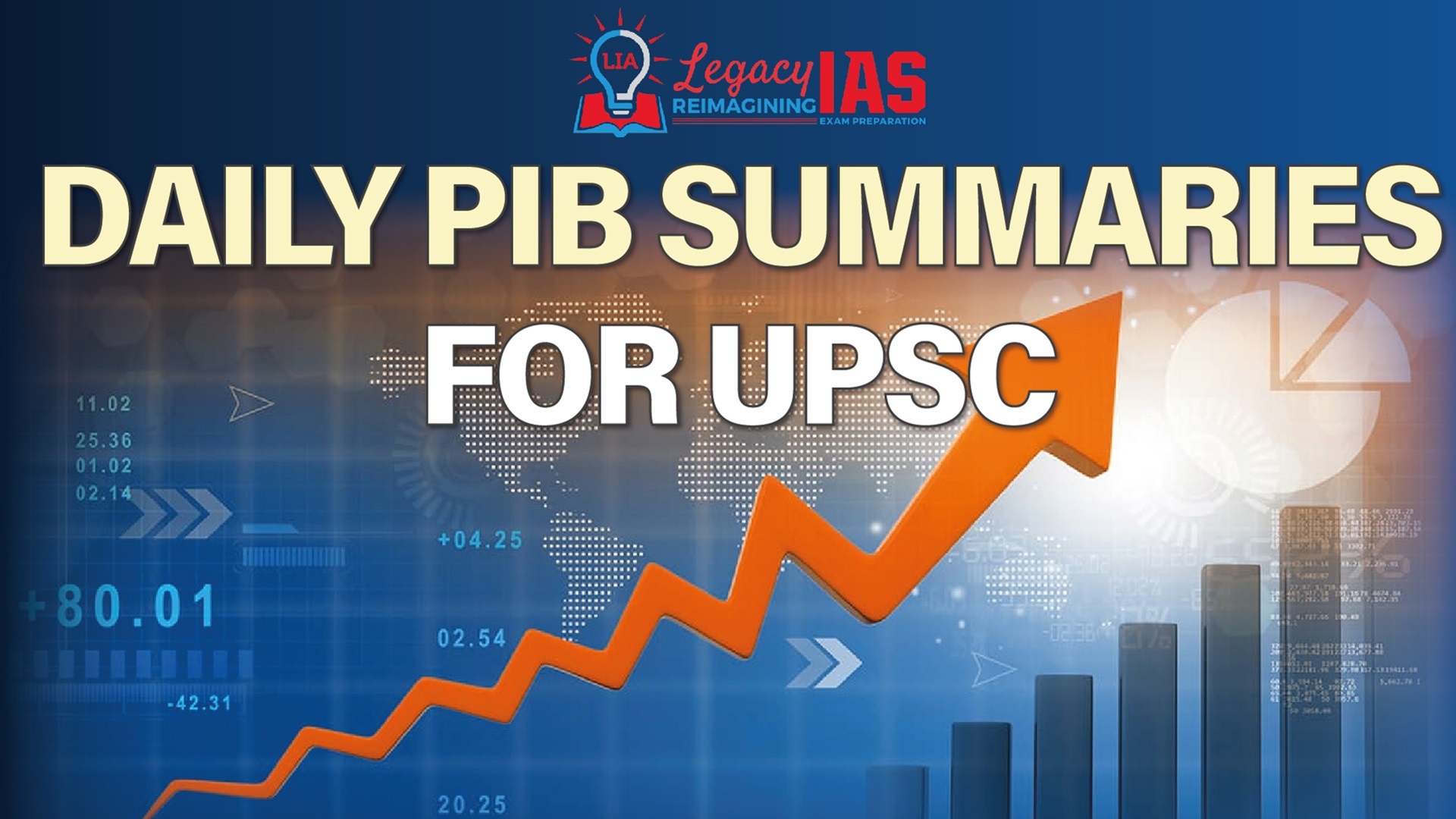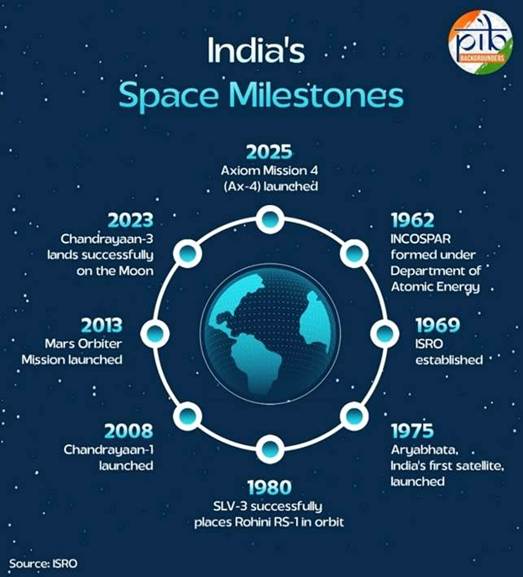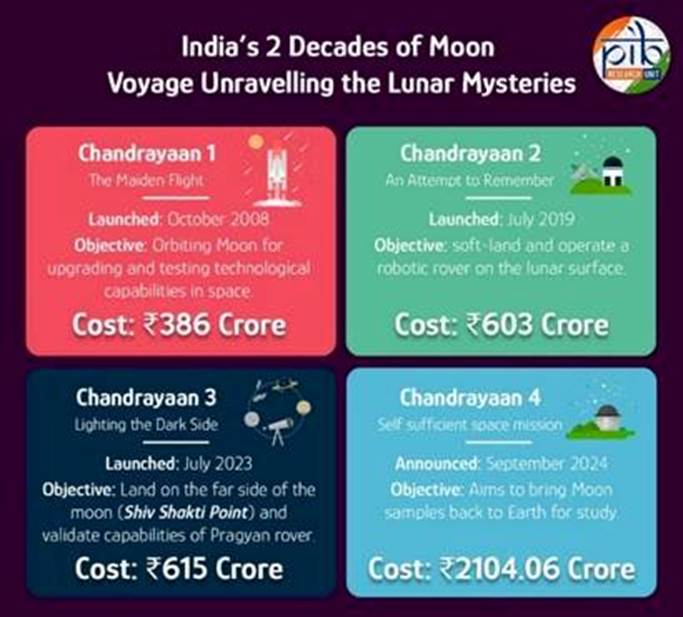
Content
- Leap Beyond: Elevating India’s Space Saga
- Rashtriya Gokul Mission
Leap Beyond: Elevating India’s Space Saga
Modest Beginnings to Global Leadership
- 1963: Launch of India’s first sounding rocket from Thumba, Kerala.
- 1975: Aryabhata, India’s first satellite, launched with Soviet assistance.
- Now: India has launched over 400 foreign satellites for 34 countries via cost-effective launch vehicles like PSLV.
Relevance : GS 3(Space )
Policy Reforms and Strategic Shift Since 2014
- Post-2014 space reforms: Opened doors to private sector and international collaborations.
- India Space Policy 2023: Defined roles of ISRO (R&D), NSIL (commercial), IN-SPACe (regulator/facilitator).
- FDI Liberalization (2024):
- 100% FDI allowed; up to 74% automatic for satellite manufacturing & operations.
- Up to 49% automatic for launch vehicles & spaceports.
- Result: Emergence of 328+ space startups, vibrant space-tech ecosystem.
Landmark Missions and Achievements
NISAR (NASA-ISRO Synthetic Aperture Radar) – Launch: 30 July 2025
- First NASA-ISRO Earth observation mission.
- Uses dual-frequency L-band (NASA) and S-band (ISRO) radar.
- Tracks:
- Earth deformation, ice sheets, forest biomass.
- Coastal changes, landslides, oil spills.
- First GSLV mission to Sun-Synchronous Polar Orbit.

Axiom Mission-4: India’s First Astronaut on ISS
- Gp. Capt. Shubhanshu Shukla became the first Indian to visit the International Space Station (ISS).
- Mission Duration: 18 days aboard ISS, returned on 15 July 2025.
- Collaborative crewed flight with Poland and Hungary, via SpaceX Dragon.
Scientific Experiments Conducted:
- Microalgae, seed sprouting, and cyanobacteria growth for nutrition and biotech.
- Tardigrade survival and human muscle regeneration under microgravity.
- User interface in zero gravity & crop seed adaptations for future agriculture in space.
Gaganyaan Programme (₹20,193 crore)
- Goal: India’s first independent human spaceflight by Q1 2027.
- Components:
- Human-rated LVM3, Crew Escape System, Service Module.
- Astronaut training for 4 IAF officers: PB Nair, Ajit Krishnan, Angad Pratap, and Shukla.
- Bharatiya Antariksh Station (BAS) by 2035; crewed Moon mission by 2040.
- Gaganyaan to catalyze:
- Space station R&D, industrial innovation, high-tech job creation.
Chandrayaan Missions: India’s Lunar Legacy
- Chandrayaan-1 (2008): Discovered water on the Moon.
- Chandrayaan-2 (2019): Partial success; orbiter still functional.
- Chandrayaan-3 (2023): First soft-landing near lunar south pole.
- Chandrayaan-4 (Upcoming):
- Sample-return mission.
- Will use 2 rockets, 5 modules, orbit docking, sample return module to Earth.
Mars Orbiter Mission (Mangalyaan)
- Launched: 2013, reached Mars orbit in Sept 2014.
- First Asian country to reach Mars on maiden attempt.
- Cost: Only $74 million, world’s most cost-effective interplanetary mission.
- Operated for 7 years (designed life: 6 months).
Solar Exploration: Aditya L-1
- Launched: 2017; orbits Lagrange point L1.
- In 2025: SUIT instrument captured rare solar flare kernel from chromosphere and photosphere.

Next-Generation Technologies
SpaDeX & Satellite Docking
- India became 4th nation to demonstrate space docking (Jan 2025).
- Enabled: Refueling, payload transfers, self-sustaining space stations.
Next Gen Launch Vehicles (NGLV)
- Reusable first stage; Payload: 30,000 kg to LEO.
- 3-stage, 93-meter tall vehicle, with 9 engines in first stage.
Orbital Re-entry Vehicle (ORV)
- Winged body for horizontal runway landings.
- Currently under testing.
Global Collaborations and Commercial Engagements
Key Partners:
- NASA: NISAR mission.
- Axiom Space: Human spaceflight (Ax-4).
- France (CNES): TRISHNA infrared resource monitoring satellite.
- Japan (JAXA): LUPEX lunar rover mission.
- Europe (ESA): Proba-3 launched aboard ISRO’s PSLV.
- SpaceX/Starlink: Received license (June 2025); expanding satellite broadband with Airtel & Jio.
Communication & Navigation Missions
NavIC (Indian GPS)
- 7 satellites in GEO/GSO; covers India + 1500 km radius.
- Applications: Military, agriculture, transportation, disaster management.
GSAT-N2 (2025)
- High-capacity communication satellite: 48 Gbps bandwidth.
- Built by NSIL, launched via Falcon-9.
Defence and Debris-Free Initiatives
Mission Shakti (2019)
- DRDO successfully destroyed a satellite in LEO.
- Proved India’s Anti-Satellite (A-SAT) capabilities.
Debris-Free Space Missions (DFSM)
- Announced in 2024, operational from 2025.
- Goal: All Indian missions to achieve 99% debris-free compliance by 2030.
- Managed by IS4OM, includes tracking, controlled re-entry, and de-orbiting strategies.
Investment & Budget Growth
- Space Budget: Tripled from ₹5,615 crore (2013-14) to ₹13,416 crore (2025-26).
- 11 years: 100 ISRO launches completed.
- Private sector-led launches increasing via NSIL and IN-SPACe facilitation.
Upcoming Missions in 2025
- PSLV-C61/EOS-09: Microwave C-band radar imaging satellite.
- TV-D2: Gaganyaan abort test with full Crew Module recovery.
- LVM3-M5: Commercial launch for AST SpaceMobile (USA).
- Chandrayaan-4, Venus Mission, Mangalyaan-2, Gaganyaan.
Strategic Vision: Space Vision 2047
- Pillars:
- Bharatiya Antariksh Station (2035)
- Crewed lunar mission (2040)
- Interplanetary missions (Venus, Mars)
- Full spectrum public-private synergy
- Embedded in India’s Amrit Kaal vision of becoming a global tech and knowledge power.
Conclusion
- India’s space journey reflects:
- A quantum leap from Earth observation to human spaceflight.
- A synergy of government reforms, private innovation, and global collaboration.
- Commitment to peaceful, sustainable, and inclusive use of space.
- With a future anchored in missions like Gaganyaan and Chandrayaan-4, and leadership in low-cost, high-impact innovation, India is now a leading spacefaring nation shaping the global space order.
Rashtriya Gokul Mission
Background and Objectives
- Launched by: Department of Animal Husbandry and Dairying, GoI
- Objective: Conservation and development of indigenous bovine breeds, genetic upgradation, and enhancement of milk productivity and production.
Relevance : GS 2(Scheme ) , GS 3(Livestock)
Key Achievements (2014–15 to 2023–24)
Increase in Bovine Productivity
- Overall bovine productivity increased from 1640 kg/animal/year to 2072 kg/animal/year
→ 26.34% increase, the highest globally. - Indigenous and non-descript cattle productivity increased from 927 kg/animal/year to 1292 kg/animal/year
→ 39.37% increase - Buffalo productivity improved from 1880 kg/animal/year to 2161 kg/animal/year
→ 14.94% increase
Surge in Milk Production
- Milk output rose from 146.31 million tonnes (2014–15) to 239.30 million tonnes (2023–24)
→ 63.55% increase in a decade
Future Target (Vision 2030)
- RGM aims to boost bovine milk productivity to 3000 kg/animal/year by 2030
Major Components and Interventions
1. Nationwide Artificial Insemination Programme (NAIP)
- Focus: Rural areas with <50% AI coverage
- Services: Free doorstep AI with High Genetic Merit (HGM) bulls, including indigenous breeds
- Impact (as of July 2025):
- 9.16 crore animals covered
- 14.12 crore AIs performed
- 5.54 crore farmers benefited
2. Progeny Testing & Pedigree Selection
- Goal: Breed and select high genetic merit bulls, especially from native breeds
- Indigenous cattle breeds supported: Gir, Sahiwal, Tharparkar, Kankrej, Hariana, Rathi, Gaolao
- Buffalo breeds supported: Murrah, Mehsana, Jaffarabadi, Pandharpuri, Nili Ravi
- Outcome: 4343 high genetic merit bulls produced and provided to semen stations
3. Accelerated Breed Improvement
- Tools used: In-Vitro Fertilization (IVF) and Sex-sorted semen
- Purpose: Rapid genetic upgradation including for indigenous breeds
4. Genomic Selection
- Aim: Faster and more precise breeding of superior indigenous cattle and buffaloes using DNA-based selection
5. Human Resource Development
- Training rural youth as:
- Multipurpose AI Technicians in Rural India (MAITRIs)
- Status (as of July 2025): 38,736 technicians trained and equipped to deliver AI services
Strategic Significance
- Boosts India’s Position: Solidifies India’s role as the largest milk producer globally
- Rural Income Support: Enhances farmers’ livelihoods, especially smallholders
- Breed Conservation: Ensures sustainable use of native genetic resources
- Technological Integration: Incorporates AI, IVF, Genomics to modernize livestock rearing
- Inclusivity: Delivers doorstep services, particularly in underserved rural districts
Conclusion
Rashtriya Gokul Mission is a transformative initiative integrating genetic science, rural capacity building, and indigenous breed conservation, resulting in unprecedented productivity gains and contributing to India’s agri-dairy resilience and rural economy. The push toward 3000 kg/animal/year productivity by 2030 reflects a bold vision backed by sustained policy and technological momentum.
